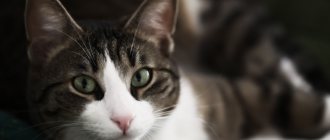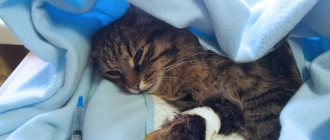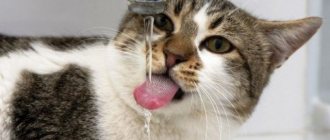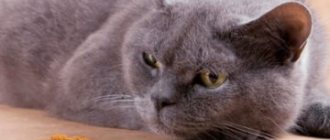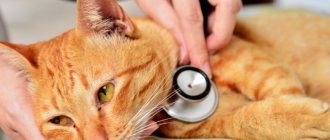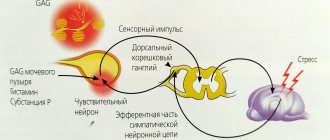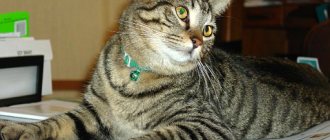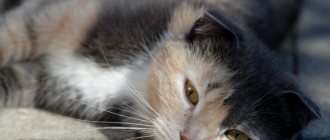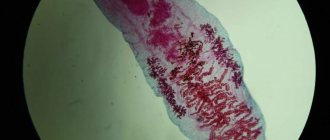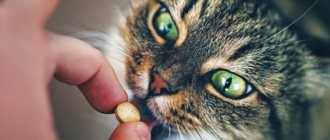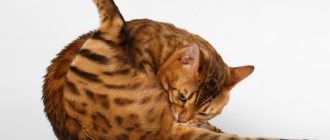Kidney failure in cats is a pathology that impairs excretory function. Waste products excreted along with urine begin to accumulate in the body, poisoning it. The danger of this disease is the prolonged absence of symptoms in the chronic form. The owners notice them only when over 65% of the tissues are already damaged. The destruction of nephrons (structural units of the kidneys) at an early stage can only be detected using laboratory diagnostics.
Causes of kidney failure and its types
Renal failure is a pathological condition in which the kidneys perform their excretory function poorly or stop performing it altogether. Due to disturbances in the functioning of the excretory system, the balances in the body are disturbed: acid-base, water-salt and osmotic. It is these disorders that eventually lead to problems in the condition of other internal organs.
Renal failure in its course and external manifestations can be:
- acute (API);
- chronic (CRF).
The disease is considered completely incurable, and in some cases can lead to the death of the cat. But timely prescribed therapy allows you to slow down its development and progression, prolonging the relatively normal life of your pet.
The most important reason for the development of renal failure is diseases accompanied by direct damage to the kidneys. Once clinical signs appear, it is almost impossible to identify the exact cause of its appearance. Any additional studies after making a clinical diagnosis reveal damage or degeneration of renal tissue, which is characteristic of almost all existing kidney pathologies.
The most common causes of kidney pathologies:
- frequent inflammation of the kidneys, as well as improper or incomplete healing;
- toxic or mechanical damage to the kidneys;
- glomerulonephritis (damage to the zona glomerulosa);
- congenital pathologies;
- infectious diseases and bacterial lesions (pyelonephritis);
- tumor processes (both benign and malignant) that impair the excretory function of the kidneys;
- renal polycystic disease (a genetic disease common to many exotic cat breeds, accompanied by the formation of cavities in the kidneys filled with fluid);
- autoimmune glomerulonephritis (genetic predisposition);
- unilateral hypoplasia (when one kidney significantly lags behind the other in development, and in old age the organ affected by the pathology simply fails - occurs only in cats).
There are breeds of cats that are predisposed to kidney failure:
Persian cats and kittens often suffer from polycystic kidney disease (even from a very young age). The animal does not live long, because... the pathology is incurable.- Abessinian cats often suffer from amyloidosis, a disorder of protein metabolism in the body. Incurable.
- Infantile polycystic disease is a disease that affects cats of the Persian breed. Obviously manifests itself in old age.
Classic symptoms
The symptoms of acute and chronic kidney failure are different. Moreover, the diagnosis of chronic renal failure can only be made by laboratory tests of blood and urine. However, there are a number of signs by which the cat owner can clearly understand that the pet has health problems due to impaired kidney function.
The main symptoms of kidney dysfunction:
Kidney problems almost always begin in cats after 8 years of age. Usually the owner notices:
- decreased activity, but chalks it all up to old age, so doesn’t pay much attention to it;
- when a cat breathes, you can smell an ammonia smell from the cat’s mouth, and drooling almost constantly;
- The animal noticeably drinks a lot and at the same time urinates frequently and a lot. Normally, a cat goes to the toilet a maximum of 3 times a day; with renal pathology, the frequency can reach up to 8-10 times (on average, 5 times is no longer the norm). Excess urine excretion is determined by the excessively wet perineum, because During urination, she manages to get very wet. Because of this, the perineum is constantly licked;
- the appetite disappears, and the cat loses a lot of weight - the ribs begin to be visible or palpable, the abdomen in the iliac region collapses;
- pink mucous membranes become clearly pale;
- swelling appears, starting from the lower parts of the paws, gradually spreading upward to the body (the paws increase in volume, become excessively soft, then soft swelling appears in the chest and abdominal cavities);
- The temperature begins to jump, both upward and downward.
In more complex cases:
- there is general lethargy;
- signs of severe dehydration (dull coat, skin does not straighten after pinching, dry mucous membranes of the mouth and eyes);
- the cat stops urinating completely (the animal never walks “smallly” once during the day);
- sudden and unexplained vomiting becomes more frequent, and blood may be present in the vomit;
- stool changes - the cat is either constipated or has bloody diarrhea;
- The nervous system is affected - convulsions or tics (single muscle twitches) may appear.
Symptoms of the disease with photos
The symptoms of kidney failure are not so easy to understand. Especially in the chronic form of the disease.
Acute symptoms
If the cause is impaired renal function due to a developing infection, a state of shock, or obstruction of the lower urinary system, then the symptoms and signs of renal failure will be pronounced and the acute form will appear very clearly.
It is especially important if suddenly the cat constantly visits the toilet, but then such visits become rare, although the animal drinks water willingly and a lot.
global $ads_google; //data-ad-slot=”2475549904″ $ads_google = empty($ads_google) ? false : true; ?> if ($ads_google == false) {?>
$ads_google = true; ?> } ?>
At the same time, the cat may experience diarrhea, nausea or vomiting. This all leads to weight loss.
Externally, the pathology manifests itself in a deterioration in the quality of wool. The mucous membranes may turn red, swelling appears, and appetite disappears.
All these symptoms should immediately alert the owner and it would be best to take the patient and go with him to a veterinary hospital to make an accurate diagnosis.
Symptoms of the chronic form
The insidious variety is characterized by a hidden course, which greatly complicates the diagnosis without veterinary experience.
Signs of chronic renal failure include increased thirst with an increase in urine volume, simultaneous loss of body weight and loss of appetite. Vomiting may occur, and the general condition is lethargic. An unpleasant odor will be heard from the mouth.
Skin turgor becomes weak, folds do not straighten out for a long time. The temperature is lowered, the kidneys can be felt by palpation due to their increased size.
Acute renal failure
Depending on the stage at which the dysfunction occurred, acute pathology is classified into the following types:
Prerenal insufficiency
It is associated with a decrease in the volume of circulating blood through the kidneys, and not with their direct damage. The condition is often preceded by any shock conditions, which are necessarily accompanied by a sharp drop in blood pressure. This is the very first (initial) stage of acute renal failure.
Main causes:
- acute cardiovascular failure;
- sun or heat stroke;
- hemorrhagic shock due to sudden massive bleeding;
- traumatic shock after extensive and severe injuries;
- hypovolemic shock due to severe dehydration of the cat;
- severe infections;
- intoxication.
Renal failure
It occurs when kidney tissues and structures are damaged.
Main provoking reasons
- bacterial or viral kidney damage (glomerulonephritis, pyelonephritis, interstitial nephritis);
- drug intoxication (use of non-steroidal anti-inflammatory drugs or aminoglycosides);
- poisoning by snake venoms;
- severe infections involving the kidneys (viral immunodeficiencies or, for example, leptospirosis);
- DIC syndrome (increased blood clotting) in severe sepsis, toxoplasmosis or intoxication with hemolytic poisons, when massive destruction of red blood cells is observed, and the renal tubules are clogged with free hemoglobin (a rare and life-threatening condition for the animal);
- kidney damage from aniline, ethylene glycol or salts of some heavy metals.
Postrenal failure
also does not lead to direct breakdown of kidney tissue, but is caused by mechanical blockage or compression of the urinary parts of the urinary system (bladder, ureter, urethra).
Causes:
- injuries to the internal organs of the pelvis;
- urolithiasis with blockage of the urinary tract with stones;
- tumors.
A favorable prognosis can be made in the first and third cases, in the second - from cautious to unfavorable.
How does it manifest?
Symptoms are distinguished by their suddenness, as well as the speed of development over a short period of time.
What owners see:
- the cat suddenly becomes lethargic and inactive;
- strong thirst appears;
- appetite completely disappears, zero reaction even to treats;
- frequent vomiting, which does not make the cat feel better;
- urine turns pink with blood;
- if the excretory tract is blocked, the cat will go to the toilet, but when trying to go to the toilet there will be no urine or it will be released in drops;
- fluctuations in the volume of urine excreted, both up and down;
- convulsions and tics (single muscle twitches) may occur;
- the cat may fall into a coma - for 2-3 days the animal supposedly sleeps, but the body is somewhat colder than usual. The condition differs from death by weak respiratory activity and no rigor mortis.
What does the vet see?
- detects the smell of acetone or ammonia from the cat’s mouth;
- notes a decrease in blood pressure (with prerenal type);
- Body temperature when measured is usually below normal, but during infections it is often elevated;
- when palpating the lumbar region, enlarged kidneys and severe pain are detected (the cat meows and tries to avoid examination);
- a bladder enlarged from urine overflow is detected, as well as free fluid in the abdominal cavity or subcutaneous tissue due to rupture of the urinary organs.
What the tests show:
- blood biochemistry: increase in creatinine, glucose and phosphates;
- urine: high protein, low specific gravity, presence of red blood cells and glucose, sediment from blood cells (neutrophils, casts, epithelial cells, lymphocytes).
Chronic renal failure
Impaired kidney function in this form of the course develops for a very long time and is due to the fact that this organ is gradually deprived of its excretory functions. Nephrons (structural kidney units) are replaced by connective tissue, scars form, the kidney shrinks and loses its working abilities. Often found in older animals.
Veterinarians practically distinguish the following main stages of renal failure:
- Latent (hidden). This is a period when the functioning of the kidneys is already impaired, but the pathology does not manifest itself in any way. It is possible to identify some deviations in the analyzes, but they are rarely done, because there is no clear indication for this.
- Initial. This period lasts up to several months and is accompanied by vague symptoms that are usually not attributed to the kidneys. Blood counts indicate obvious pathology.
- Conservative. Most often, the diagnosis of chronic renal failure is made precisely during this period - the history of the disease and life, direct examination and indicators of nitrogen and creatinine in the blood give every reason for this.
- Terminal. Deviations in the functioning of some other organs begin to appear, the levels of creatinine and urea in the blood go off scale. The animal will die without hemodialysis or surgery.
At stages 3 and 4, the diagnosis is easiest to make, however, this is already a reason for a cautious and unfavorable prognosis. Symptoms of chronic renal failure begin to appear when the kidneys are damaged to at least 65-70% (sometimes up to 80%).
Probable Causes
- metabolic pathologies (diabetes mellitus, amyloidosis - a disorder of protein metabolism in the body);
- tumor process in the kidneys;
- conversion from acute renal failure;
- against the background of chronic pancreatitis (inflammation of the pancreas);
- urolithiasis of the kidneys;
- any chronic kidney disease associated with viruses or bacteria (pyelonephritis);
- congenitally underdeveloped kidneys and their structures;
- renal polycystic disease (limited cavities with fluid form throughout the “body” of the kidney. Persian cats are most often affected).
With all the variety of causes that provoke chronic renal failure, it is practically impossible to find out exactly due to the profound degeneration of the renal structures at the time of diagnosis
How does it manifest?
The degree of manifestation of symptoms directly depends on the degree of kidney damage at the time of detection of abnormalities.
What owners see:
- the cat stopped eating completely;
- depressed and lethargic, sleeping most of the time;
- the animal is clearly losing weight, the costal arches begin to appear and the stomach begins to fall in;
- almost constant drooling, nausea (manifested by constant licking of the lips and nose), periodic vomiting not associated with food or water intake;
- perversion of taste preferences - the cat may begin to eat inedible objects (for example, toilet filler granules);
- the animal often begins to go to the toilet (up to 6-8 times a day), and the amount of urine may increase or decrease;
- increased nervous excitability, inadequate reactions to loud sounds (the cat gets scared even when called loudly - it twitches, presses itself to the floor or runs away);
- constipation appears, bowel movements are observed every few days;
- at the terminal stage, confusion, twitching of individual parts of the body or paws (tics), convulsions, and coma may be noted.
What does the vet see?
- extensive swelling starting from the paws and moving to the chest and abdomen;
- slow heart rate (bradycardia);
- blood pressure jumps up (hypertension);
- the coat is dull, brittle, cannot be laid evenly, with areas of alopecia;
- noticeable softening of the facial bones when palpated (due to a lack of calcium and excess phosphorus);
- pallor of the mucous membranes in the mouth;
- stomatitis with ulcerations on the tip of the cat's tongue (an important clinical sign);
- the kidneys can be easily felt and a change in their size in any direction (enlargement or shrinkage) is detected.
What do the tests show?
- obvious anemia;
- the level of creatinine and glucose in the blood rises;
- Sugar and protein are detected in the urine, and its specific gravity decreases.
- Ultrasound: changes in the contours of the kidneys (often becoming uneven when wrinkled);
- change in size (usually decrease, but can also increase).
Stages of development of chronic pathology
Veterinarians distinguish several stages in the development of chronic renal failure:
- Hidden (latent) - pathological changes do not manifest themselves externally, but the kidneys are already working abnormally; deviations in urine parameters may be detected during tests (however, they are not done due to the lack of indications). Among the external signs of the cat you can notice slight lethargy and thirst.
- The initial stage (lasts several months) has vague symptoms, but pathology can already be seen based on blood and urine indicators. The cat begins to visit the litter box more often, and the urine becomes denser due to the growth of protein and red blood cells in its composition.
- The conservative stage at which the disease is most often detected, when the owner pays attention to changes in the behavior and condition of the pet. During this period, the amount of urine decreases and gradually stops, which is accompanied by the appearance of symptoms of poisoning. Negative signs become apparent only when the kidneys are already 65-70% damaged, so the prognosis for the animal’s life becomes unfavorable.
- The terminal stage (severe form) begins when malfunctions of other organs occur due to toxins accumulated in them; in blood tests, urea and creatinine levels increase sharply. Without urgent surgical intervention and hemodialysis, the animal may die.
Among veterinarians, chronic renal failure is considered an incurable disease, but many owners agree to maintenance therapy, trying to prolong the life of the pet and alleviate its condition (a favorable prognosis allows one to hope for a period of 3-4 years).
Diagnostic features
A condition in which there are disturbances in the functioning of the excretory system is rarely determined by external signs - the symptoms can suggest or suspect the disease. This is also explained by the fact that the symptoms are “masked” as other diseases, which are excluded only with the help of additional research methods.
An accurate diagnosis of renal failure is made only based on the results of a comprehensive examination with the obligatory implementation of:
- examination and collection of a detailed medical history (medical history and lifestyle);
- laboratory tests of urine and blood;
- Ultrasound of the kidneys and abdominal organs;
- fluoroscopy of the kidneys.
The diagnosis of chronic renal failure is made ONLY after laboratory tests of blood and urine.
When analyzing urine it is noted:
- increased protein levels (proteinuria);
- the presence of leukocytes and erythrocytes;
- presence of sediment;
- decrease in its density (isosthenuria);
- pH shift to the acidic side.
Blood chemistry:
- increased urea;
- increase in creatinine level;
- fluctuations in the amount of protein in either direction;
- decreased potassium levels;
- increase in the level of calcium, magnesium and phosphorus (with chronic renal failure);
- increased sodium levels.
General blood analysis:
- decrease in hematocrit values;
- decreased hemoglobin levels;
- increase in the number of leukocytes;
- drop in platelet and lymphocyte levels.
Differentiation of acute renal failure and chronic renal failure:
- in case of acute renal failure, anemia does not have time to develop due to the transience of movement, in case of chronic renal failure it is clearly expressed;
- CRF begins smoothly and lasts a long time; at the time of diagnosis, the prognosis is most often unfavorable; AKI manifests suddenly with a lightning-fast course, the prognosis is favorable with timely diagnosis and proper treatment;
- when palpating the kidneys in chronic renal failure, they are almost always painless, while in acute renal failure the pain syndrome is clearly expressed;
- in case of acute renal failure the clinic is bright, in case of chronic renal failure it is not or is very blurred.
Are there preventive measures?
Although most diseases can be prevented, kidney failure can only be detected at an early stage of development with regular annual medical examinations, and in older cats - with blood and urine tests every six months. If these procedures are not performed on the animal, then the disease will be detected in a state where there is a high risk of not curing it.
Regular examinations should be supplemented by proper and balanced nutrition (ideally, commercially produced “wet” food). There is nothing more that owners can do to prevent kidney failure in cats.
Prevention and diagnosis of disease in cats
To prevent such a gloomy scenario in the life of your pet, you should take care of its health in advance. And in order to prevent the disease, the animal’s diet and drinking regime are very important. Domestic cats, especially older ones, should be gradually transferred to therapeutic food. A diet for the prevention of chronic renal failure should consist of foods with a minimum amount of proteins and phosphates. This food can be purchased ready-made, but this step must first be agreed with a veterinarian.
In order to avoid a tragic ending, pets should undergo an annual medical examination, and those who have reached old age and have been living in the family for more than ten years should undergo a thorough check twice a year. Give your cat more water and monitor her behavior, then she will live a healthy and happy long life with you.
Treatment
It should be repeated that this pathology is not completely eliminated. The kidneys return to a state of maximum functionality, to the extent possible for a particular degree of damage. You will have to monitor your kidney function for life, at regular intervals determined by your doctor, taking the necessary tests. Treatment will directly depend on the course - acute or chronic.
Procedure for treating acute renal failure
- Identifying and eliminating the root cause.
- Removing the animal from a state of dehydration.
- Elimination of hemolysis.
- Removing intoxication.
- Hemodialysis (in especially severe cases).
- Recovery diet.
Treatment procedure for chronic renal failure
- Maintenance diet and appetite stimulation.
- Normalization of blood pressure and compensation of heart failure.
- Restoration of water-salt balance, acid-base and mineral.
- Elimination of signs of anemia.
- Fortification.
- Hemodialysis.
List of medications used
Below is a list of the most commonly used medications for kidney failure. Only a veterinarian can combine medications and draw up therapeutic treatment regimens from them! It is strictly forbidden to try to self-medicate your pet!
Antibiotics
To eliminate the primary factors of kidney failure (pyelonephritis), fluoroquinolone antibiotics are prescribed, which do not put additional stress on the kidneys:
- enrofloxacin: intramuscularly 5 mg/kg cat body weight for 5 days. In rare cases, you can extend the course to 7-10 days;
- ciprofloxacin: 5-15 mg/kg body weight for up to 5 days.
Hormonal drugs
The use of glucocorticoids helps suppress immune reactions that provoke glomerulonephritis, increase diuresis (while suppressing antidiuretic hormone), relieve swelling directly in the renal tissues, and also increase appetite in cats.
- In the acute course of the disease, it is best to start with: dexamethasone: 0.2 mg/kg intramuscularly or intravenously until the general condition stabilizes and the water balance is normalized.
- methylprednisolone: 3 mg/kg intravenously once daily for 4-5 days;
Diuretics
They are prescribed in any case: furosemide (considered best for renal failure): 0.1 ml/kg twice daily into the muscle. Monitor the effect. In its absence, the permissible increase in dosage is 2-3-4 times.
Potassium-containing drugs
The loss of potassium is replenished with special potassium-containing drugs, but always under laboratory control of its content in the blood: panangin (asparkam). Application: orally, 1 tablet/10 kg of weight up to 3 times a day until the condition stabilizes.
Laxatives
Laxatives for stool retention and prolonged constipation:
- lactulose (Duphalac), lactusan: orally 0.5 ml/kg until stool normalization. Can be taken until the end of the entire treatment therapy, because is not addictive;
- bifidum 791 BAG - live bacteria that improve intestinal digestion and speed up bowel movements: 1 dose per 1 cat orally with a small amount of chilled boiled water throughout the entire course of treatment.
Rehydration and nutrient solutions
Intravenous or subcutaneous drips with rehydrating and nutrient solutions that restore salt and mineral metabolism, as well as eliminate dehydration:
- Ringer-Locke solution + glucose 40%: 500 ml + 50 ml;
- trisol: calculated 7% of total body weight once;
- rehydration mixture of glucose solution 40% + vitamin C 5% + saline: 15-55 ml/kg by slow dropper, depending on the severity of dehydration.
Antiemetic therapy
- metoclopramide: 0.5-0.7 mg/10 kg body weight subcutaneously or intramuscularly as vomiting occurs, but not longer than 5 days;
- ondansetron: 0.5 mg/kg into muscle symptomatically.
Reduced pressure
Reducing blood pressure is achieved with ACE inhibitors:
- enalapril: the dosage is selected individually for each sick animal. The target (maximum) effective dose is 0.5 mg/kg of the cat’s body weight – you cannot give it all at once, so as not to provoke a sharp drop in blood pressure and collapse. You need to start with 1/8-1/9 of the target dose to give the body time to get used to the hypotensive effect. Increase the dose gradually until the condition normalizes. Maintenance dose: ½ part of the target dose;
- Ramipril (inactive prodrug): 0.125 mg/kg body weight once daily.
For the cardiovascular system
Cardiogenic drugs to support the state of the cardiovascular system:
- cocarboxylase: 1-1.5 ml per cat (5 mg/kg) once or twice a day intramuscularly (sometimes done subcutaneously or intravenously);
- Riboxin: 0.1-0.2 g/10 kg intramuscularly or intravenously;
- sulfocamphocaine: 0.1 ml/kg body weight subcutaneously until the condition normalizes.
Detoxification products
- enterosgel: 20 g/10 kg of pet’s weight once a day;
- liarsine: 0.5-2 ml per animal 1-2 times a day for 10-14 days;
- plasmapheresis (removal of toxins from the bloodstream by purifying blood plasma using protein-saline solutions);
- sirepar: 1.5-3 ml every day until signs of intoxication subside;
- Lespenefril (to remove nitrogenous substances from the blood): ½ tsp. per animal with a small amount of water inside 1 time/day for a month.
To eliminate anemia
Maintaining the hematopoietic process to eliminate anemia is achieved with hematopoietic drugs:
- Recormon: 25-50 IU/kg 1-3 times a week until the hematocrit level reaches 30%. The drug is taken continuously if it is not possible to achieve the desired level;
- ursoferran: once in a dose of up to 0.5 ml per animal into the muscle or subcutaneously;
- hemobalance: for a cat weighing up to 5 kg - 0.25 ml, over 5 kg - 0.5 ml intravenously or intramuscularly 1-3 times a week for a course of 7-10 injections.
Hemostatic drugs
In acute renal failure, it is necessary to use hemostatic agents to prevent gastrointestinal bleeding;
- dicinone: 0.5 ml up to two times a day for 5-7 days;
- Vikasol: 1-2 mg/kg once a day. Average course: 3-5 days.
- aminocaproic acid: 8-10 mg/kg orally (by mouth).
With complete lack of appetite
A nutrient mixture is prepared, which is given hourly in 5 ml doses using a syringe without a needle or a small rubber bulb. Mixture composition: 100 ml milk and water, 1 tsp. starch, 2 tsp. sugar - bring to a boil. Then a whole raw chicken egg and 1 crushed mezim tablet are added to the cooled solution. As appetite appears, the time interval decreases and the amount of mixture increases.
To support the gastrointestinal tract
With kidney failure, the production of gastrin (the hormone that activates digestion) is inhibited, which causes a lot of stomach acid to form in the stomach. In this case, urea in the stomach turns into ammonia, irritates the gastric mucosa and can provoke a peptic ulcer. To maintain the functioning of the gastrointestinal tract and protect the gastric mucosa, the following is prescribed:
- ranitidine: 2 mg/kg by slow intravenous injection or 3.5 mg/kg orally twice daily at regular intervals;
- famotidine: 0.5-1 mg/kg intravenously or subcutaneously up to twice a day.
Principles of therapy for acute and exacerbation of chronic forms
To prescribe therapeutic measures for acute renal failure, the doctor first determines the causes of the disease or its exacerbation in order to take measures to eliminate them. For infectious forms of the disease, antibacterial agents are immediately prescribed; for poisoning, antidotes are prescribed. Most often, treatment of acute failure is carried out in a hospital, under the supervision of a veterinarian.
When treating acute kidney failure in cats, a mandatory procedure is hemodialysis - purification (filtration) of the blood from toxic products, which allows normalizing the water balance in the body.
The following therapeutic measures are also applied:
- administration of intravenous rehydration and nutritional solutions to restore urine outflow and relieve dehydration (Trisol, Ringer-Locke solution, glucose, vitamin C);
- intramuscular injections of Papaverine and No-shpa to reduce pressure and dilate blood vessels in the kidneys;
- anti-inflammatory drugs (Amoxicillin, Ciprofloxacin, etc.) - help eliminate primary factors (pyelonephritis, etc.) at the initial stage;
- painkillers and antiemetics.
The purpose depends on the general condition of the animal, the established causes and the severity of the disease.
Diet
Diet plays a leading role in the treatment of any form of renal failure. Last for at least 6-9 months, it is prohibited to switch to regular cat food immediately after the symptoms pass!
You can't feed:
- dairy products;
- in excess of meat products;
- fish oil;
- foods containing excess vitamin A;
- add salt.
In cats, you can use ready-made industrially produced dietary food (with urea up to 20 mmol/l). In severe conditions, it is better to follow a strict protein-free diet (with urea from 30 mmol/l) with an increased amount of flour and sweet foods (“pancake” diet).
Food for cats with kidney failure should be limited not only in the amount of protein, but also in phosphorus. After eating, you can take almagel (1-2 ml for one cat), which will bind it and remove it.
The outcome of treatment for renal failure directly depends on how early the diagnosis was made and how quickly therapeutic and restorative therapy was started. Do not neglect preventive examinations of your pets and blood tests, because... sometimes these are the only ways to identify kidney pathologies.
Author:
Grinchuk Ekaterina Andreevna veterinarian
